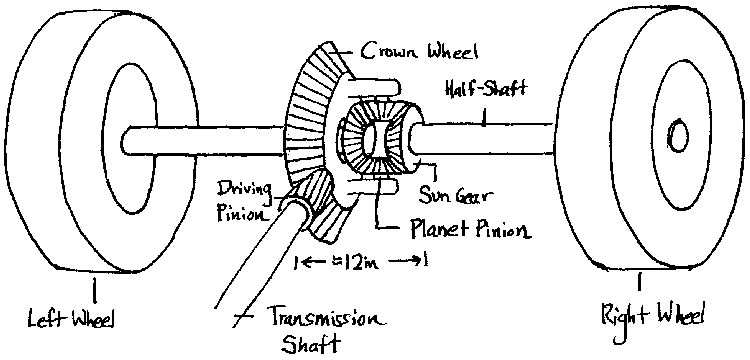While driving a car have you ever wondered how does the engine drive the wheels? How only one engine drives all the wheels of the car? How does the system manage to transmit the power to the wheels? Let’s have a brief look under the hood and understand a very important concept of an automobile, that is “DIFFERENTIAL”.
Engineering of an automobile is a very vast subject. On an average, about 30,000 parts are used for the manufacturing of a single car. Hence to study automobile, the whole subject is divided into 6 major systems: Chassis, Engine, Transmission, Steering, Braking, Suspension. Differential is a part of Transmission system.
Main aim of transmission, as the name suggests is to transmit the power produced by the engine to the wheels so that the vehicle moves. A transmission in general consists of an input shaft, an output shaft, gears and a differential. The input shaft gets power directly from the engine, which is manipulated according to our needs by gears and finally the output shaft carries the final power.
The differential then comes into action. The differential transmits the the power produced by the output shaft sideways. 
As shown in the picture, the differential is situated between the two wheels and it transfers the motion of transmission shaft/output shaft to the rotary motion of the wheels. The transmission shaft rotates the driving pinion, which in turn drives the ring gear (crown wheel). This ring gear is attached to a small sun gear/side gear. This side gear is meshed via the differential pinion gear(planet gear). Both the side gears are connected to the half shafts(axle) connected to the wheels.
Why to use the side gears pinion assembly when we can directly connect the ring gear? Also this work seems to be easy. But this is not all a differential does. A differential is designed for a far more greater purpose.
Whenever an automobile turns, there is a difference in the speeds of the inner and the outer wheels.

As you can see, the outer wheel of the automobile has to travel a larger distance than the inner wheel in the same amount of time while turning. Hence the speed of outer wheel is more. This can be achieved by unequal and proportionate distribution of power to the wheels. The outer wheel needs more power than the inner wheel and this unequal but proportionate distribution of power is done by the differential.
The inner half shaft in the figure indicated the part of the shaft connected to the inner wheel while the outer half shaft to the outer wheel. Both the shaft move in anticlockwise direction when moving on a straight road. Hence the power is distributed equally and both the side gears hence the shaft rotate at same speed.
While turning, both shafts do rotate in the same direction. The outer wheel has to move at higher speed than the inner wheel. This produces a couple moment at the differential pinion. This force drives the pinion gear to rotate. Due to this rotation, the side gear of the outer shaft rotates at a rate higher than the inner wheel. The side gear of outer shaft gets an additive rpm while the inner shaft gets a subtractive rpm. Hence due to this production of different speeds in both the wheels, the system is called a differential.
Hence for different turns, different torque is applied on the differential pinion and according powers are provided to the wheels. This was the basic information about differential and transmission. Further the differentials are classified into different types differentials like open differential, locking differential, limited slip differential, electronically controlled limited slip differential, torque vectoring differential etc. But for basic understanding of the differential, this much knowledge is enough.
